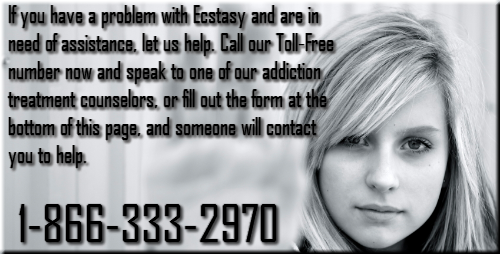Ecstasy Effects
- Ecstasy Addiction
- Ecstasy Overdose
- Ecstasy and Brain Damage
- Dangers of Ecstasy
- Ecstasy Side Effects
- Ecstasy Long Term Effects
- Ecstasy Deaths
- Ecstasy Addiction Treatment
- Symptoms of Ecstasy Use
Ecstasy Information

Statistics about Ecstasy
Statistics about Ecstasy: ER Data
- Statistics about ecstasy show that ecstasy related emergency room incidents increased nationwide from 250 in 1994, to 637 in 1997, to 1,142 in 1998, and 2,850 in 1999.
- Emergency room visits involving MDMA have increased nearly 2,000 percent in the U.S., from 253 visits in 1994 to 4,023 in 2002.
Statistics about Ecstasy: Parents
- Prior research has shown that youths and young adults who are current ecstasy users are more likely than nonusers to use other illicit drugs.
- Only one in four parents (24 percent) say they’ve talked with their children a lot about ecstasy in the past year; just three percent believe their teenager may have used ecstasy already.
- Statistics about ecstasy show that 41 percent of parents have never talked with their kids about ecstasy.
- Among drugs parents talk with their kids about, ecstasy was less likely to be discussed than any other drug – illicit or licit.
- More than half of parents (52 percent) say they need additional information on the dangers of ecstasy.
Statistics about Ecstasy: Usage Data
- About 8% of high school seniors surveyed had tried ecstasy at least once in their lives.
- About 5.5% of 19-22 year olds surveyed had used ecstasy in the previous year.
- In 2000, approximately 6.4 million people had tried ecstasy at least once in their lifetime.
- In July 2000, the U.S. Customs Service at Los Angeles International Airport seized 16 packages containing 2.1 million Ecstasy tablets (1,096 pounds) with an estimated street value of at least $41 million.
- Statistics about ecstasy show that 28% of teens know a friend or classmate who has used ecstasy, with 17% knowing more than one user.
- 10% of teens say that they have been to a rave and ecstasy was available at more than two-thirds of these raves.
- Statistics about ecstasy show that among 12th graders, ecstasy use rose from 5.6% in 1999 to 8.2% in 2000.
- Use of ecstasy continued to rise among American teenagers in 2001, following sharp increases among young adults and adolescents in recent year. However, the rate of growth is finally beginning to slow. That result comes from the national survey in the Monitoring the Future series, conducted annually for the past 27 years by the University of Michigan Institute for Social Research, Ann Arbor, which included about 44,000 students in 424 public and private secondary schools.
Statistics about Ecstasy: Ecstasy
- Ecstasy tablets seized by the Drug Enforcement Administration increased from 13,342 in 1996 to 949,257 in 2000.
- Statistics about ecstasy show that a typical doses of ecstasy range from around 80 to 160 milligrams of MDMA when taken orally.
- The amount ecstasy smuggled from Europe to the United States is worth more than $3 billion. Some comes from Britain or it is trafficked by gangs with connections in the UK according to European police sources.
Statistics about Ecstasy: Effects and Side Effects
- Statistics about ecstasy show that when ecstasy is taken by mouth, the effects manifest about 30-45 minutes later.
- Research suggests that people who used ecstasy at least 25 times had lowered serotonin levels for as long as a year after quitting.
Statistics about Ecstasy: Treatment Data
- Statistics about ecstasy show that the number of persons being admitted for treatment of ecstasy addiction is increasing rapidly in Denver, Minneapolis/St. Paul, and Texas.
